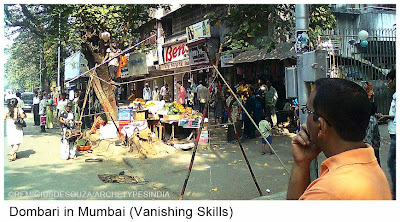Relics of British Raj in Bombay
Very few of these cast iron vent pipes fixed to the sewer drains are left in Mumbai's island city. These vent pipes; about five of them are on Dada Saheb Phalke Marg.
Their height indicates Bombay's city scale then. Now Mumbai is aiming for sky, with glass-clad skyscrapers.
Their height indicates Bombay's city scale then. Now Mumbai is aiming for sky, with glass-clad skyscrapers.
It is heartening to see people paddling bicycles even today. Banyan trees also add to the city's past. Now the defunct Gold Mohor Mill is on the breaking point. It will be taken over perhaps by new commercial buildings, sooner or later.
The cast iron vent pipes were imported from Britain about two hundred years ago. Of course, from pin to power-loom, most machine-made items ware once imported.
Every piece assembled in this pipe has the maker's name, “CEO. GAHAGAN & CO. LTD.”, placed (See Fig.5). In those days there was no need of mentioning 'Made in Britain'.
The cast iron vent pipes were imported from Britain about two hundred years ago. Of course, from pin to power-loom, most machine-made items ware once imported.
Every piece assembled in this pipe has the maker's name, “CEO. GAHAGAN & CO. LTD.”, placed (See Fig.5). In those days there was no need of mentioning 'Made in Britain'.
Britain had once invaded 90% countries of the world. Now we may change the names of places, remove statues, repeal acts, but the list is endless. How can we remove deep impressions on our psyche — particularly the elite groomed by British-made education?
City services, such as water supply, drainage etc. should generally last for 200 to 300 years, while those for houses last for 30 to 40 years. This calls for repairs and replacements.
However, the Urban Explosion has been taking place at unprecedented rate, which is worldwide phenomenon, not only in India. It is a gift of Industrialization.
City services, such as water supply, drainage etc. should generally last for 200 to 300 years, while those for houses last for 30 to 40 years. This calls for repairs and replacements.
However, the Urban Explosion has been taking place at unprecedented rate, which is worldwide phenomenon, not only in India. It is a gift of Industrialization.
 |
| 4. Detail-1, Old city sewer vent pipe, Mumbai |
The drainage, water supply systems have been under pressure, and are replaced. Obviously these sewer vents have been long defunct.
The citizens should generally be aware of such issues, irrespective of politics of power and patriotism in polarization.
It is not only water supply and drainage but there are many other vital public services: health, education, post and telegraph, gas, electricity, transport...open spaces and, of course, spaces for the cultural needs of the people, especially in the Pluralistic Indian Society.
The citizens should generally be aware of such issues, irrespective of politics of power and patriotism in polarization.
It is not only water supply and drainage but there are many other vital public services: health, education, post and telegraph, gas, electricity, transport...open spaces and, of course, spaces for the cultural needs of the people, especially in the Pluralistic Indian Society.
 |
| 4. Detail-2, Old city sewer vent pipe, Mumbai |
In the democratic society, the duty to bring this awareness among the people falls on the shoulders of media — radio, TV, newspapers... or multimedia, as non-formal education; besides all the levels and streams of the mass education — public or private. Entertainment is trivial aspect of living, not vital issue, but unduly exaggerated by the entertainment industry.
~ ~ ~ ~ ~
© Remigius de Souza. All rights reserved.











































